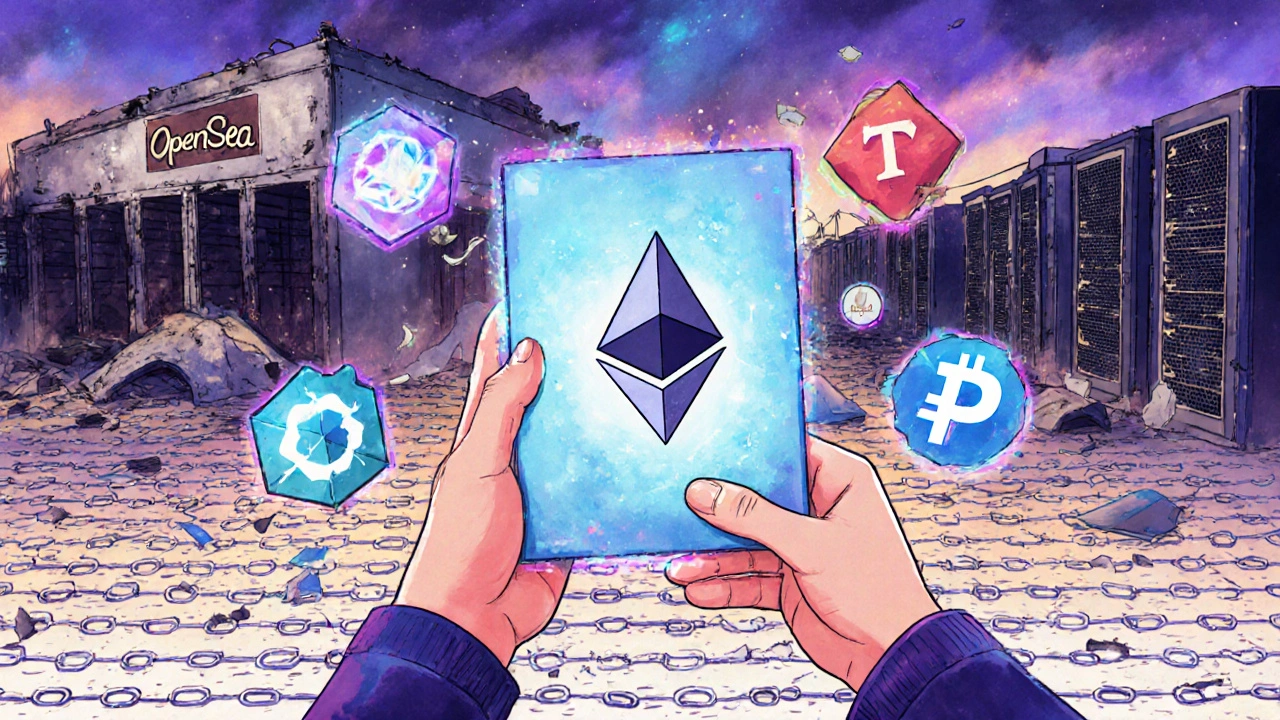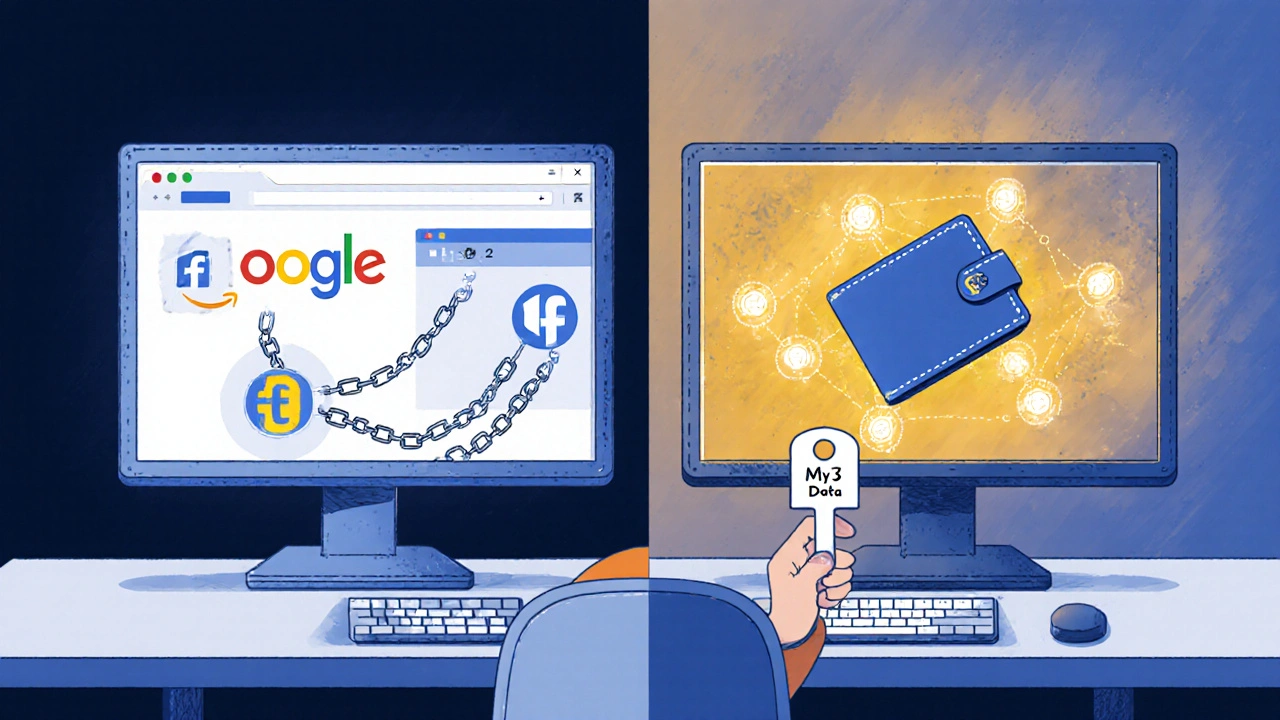Web3 isn’t just another buzzword tossed around by tech bros. It’s the next version of the internet - one where you actually own your data, your money, and your digital stuff. If you’ve ever felt like big companies like Google, Facebook, or Amazon control too much of your online life, Web3 is the fix. It’s built on crypto and blockchain tech, but it’s not about buying Bitcoin or trading NFTs. It’s about changing how the whole web works.
What Web3 Actually Means
Web1 was the early internet - mostly static pages you could read but not interact with. Web2 is what we use today: social media, YouTube, TikTok, Amazon. You post, share, and buy, but the platforms own your data, your profile, and your attention. They sell your data to advertisers. They can delete your account anytime. You don’t own your digital identity.
Web3 flips that. It’s built on blockchain networks like Ethereum, Solana, and Polygon. Instead of companies running servers in data centers, Web3 runs on thousands of computers around the world. No single company owns it. That’s what decentralization means. You interact with apps using a crypto wallet - like MetaMask or Phantom - not a username and password.
Think of it like this: In Web2, you rent your online life. In Web3, you own it.
How Web3 Uses Crypto
Crypto isn’t just money in Web3 - it’s the fuel. Every action on a Web3 app usually costs a tiny bit of cryptocurrency, called a gas fee. That’s how the network pays people who run the computers keeping everything running. But crypto also gives you ownership.
Let’s say you buy a digital artwork as an NFT on OpenSea. In Web2, that’s just a JPG file stored on someone else’s server. If OpenSea shuts down, you lose it. In Web3, the NFT is recorded on a blockchain. You hold the private key. Even if OpenSea disappears, your NFT is still yours - you can move it to another platform, sell it, or display it in a virtual gallery.
Crypto tokens also let you vote. Some Web3 projects give you governance tokens. Hold enough, and you can vote on changes to the app - like how fees are set, what features get added, or who gets funded. It’s like being a shareholder in a company, but without the corporate ladder.
Real Examples of Web3 in Action
Web3 isn’t theoretical. People are using it right now.
DeFi (Decentralized Finance) lets you lend, borrow, or earn interest without a bank. Apps like Aave or Compound let you deposit crypto and earn yield. No credit check. No paperwork. Just code running on a blockchain.
Play-to-earn games like Axie Infinity let players earn crypto by playing. In traditional games, you spend hours grinding, and the company keeps all the value. In Axie, your in-game creatures are NFTs. You own them. You can sell them for real money.
Even social media is changing. Mastodon is a decentralized alternative to Twitter, but Web3 versions like Lens Protocol let you own your profile and followers. You can take your audience with you if you leave one app - no platform can lock you in.

Why Web3 Matters to You
Most people don’t care about blockchain. But they care about control. They care about not getting banned from a platform they’ve spent years building on. They care about not paying $30 a month for cloud storage when they could store their photos on a decentralized network for pennies.
Web3 gives you back power. You don’t need to trust a company anymore. You trust math - code that runs exactly as written, on thousands of computers, forever. If you’ve ever been locked out of an account, had your content demonetized, or had your data sold without consent, Web3 offers a real alternative.
It’s not perfect. It’s still early. Apps can be clunky. Fees can spike. Scams exist. But the core idea - ownership, control, openness - is powerful.
What Web3 Isn’t
Web3 isn’t a get-rich-quick scheme. Buying a random NFT because someone on YouTube said it’ll moon isn’t Web3 - that’s gambling.
Web3 isn’t just crypto trading. You don’t need to day-trade tokens to use Web3. You can use a decentralized email service, store your documents on IPFS, or join a DAO - all without touching a trading app.
Web3 isn’t anti-internet. It’s pro-user. It doesn’t want to replace Google or YouTube. It wants to give you the option to use them without handing over your soul.

How to Start Using Web3 Today
You don’t need to be a coder to start. Here’s how:
- Get a crypto wallet. Download MetaMask (for desktop) or Phantom (for mobile). It’s free.
- Buy a small amount of ETH or SOL - $10-$20. Use a trusted exchange like Coinbase or Kraken.
- Try a simple Web3 app. Use Arweave to store a photo permanently for under $0.10. Or join a Discord community running on Lens Protocol.
- Don’t send crypto to strangers. Never share your seed phrase. Treat it like your house keys.
That’s it. You’re using Web3.
The Future of Web3
Right now, Web3 is like the internet in 1995. Few people understand it. Most apps are clunky. But the potential is huge.
Imagine a world where:
- Your medical records are stored on a blockchain - you control who sees them.
- You get paid in crypto for writing reviews, not just giving data to Facebook.
- Your music is directly sold to fans, no record label taking 80%.
That’s not sci-fi. It’s already being built.
Web3 won’t replace the internet overnight. But it’s giving people a choice. And that’s the most important thing.
Is Web3 the same as Bitcoin?
No. Bitcoin is a digital currency. Web3 is the whole next-generation internet built on blockchain tech. Bitcoin is one part of Web3 - like email is one part of the modern web. Web3 includes decentralized apps, NFTs, DAOs, and more.
Do I need to buy crypto to use Web3?
Not always. You can explore some Web3 tools - like decentralized storage or forums - without spending money. But to truly interact with most apps (like lending, gaming, or social platforms), you’ll need a small amount of crypto to pay for network fees. Start with $5-$10.
Is Web3 safe?
The code behind Web3 apps is often open and secure. But you’re responsible for your own wallet. If you lose your private key or send funds to a scam site, there’s no customer service to help you. Always double-check addresses. Never share your seed phrase. Treat it like your bank PIN.
Can Web3 replace Google or Facebook?
Not right now. Google and Facebook are fast, easy, and free. Web3 apps are slower and require more effort. But they offer something those giants don’t: ownership. Over time, as Web3 apps get better, more people will choose them - not because they’re perfect, but because they’re yours.
What’s the point of Web3 if it’s so complicated?
It’s not for everyone - and it doesn’t have to be. The point isn’t to make everyone switch overnight. It’s to prove that the internet doesn’t have to be controlled by a few corporations. Even if only 5% of users adopt Web3, it forces the big platforms to change. That’s already happening.
Web3 isn’t about tech jargon. It’s about freedom. Freedom to own your stuff. Freedom to move without permission. Freedom to build without asking for approval. That’s why it matters - whether you use it today or not.

